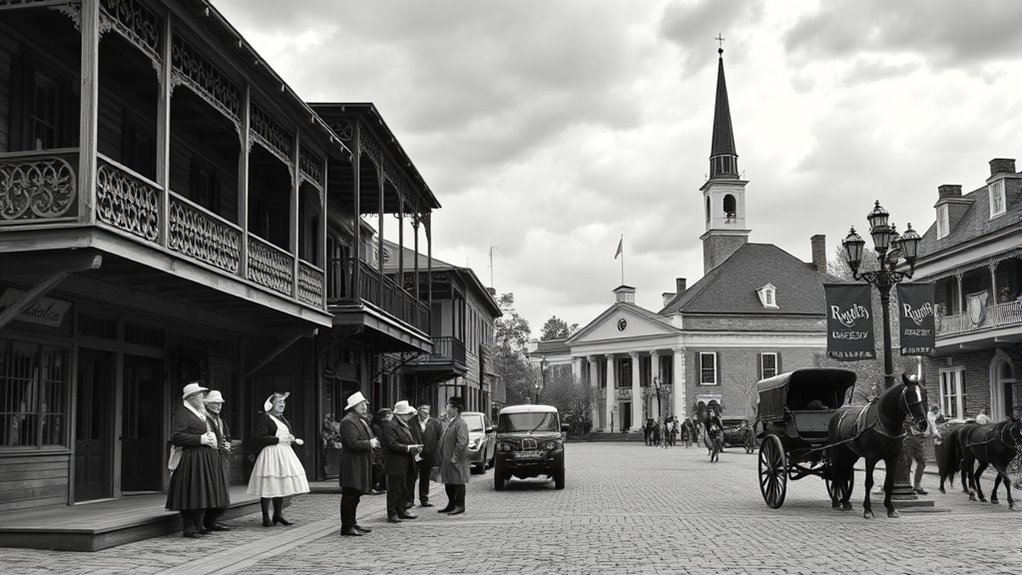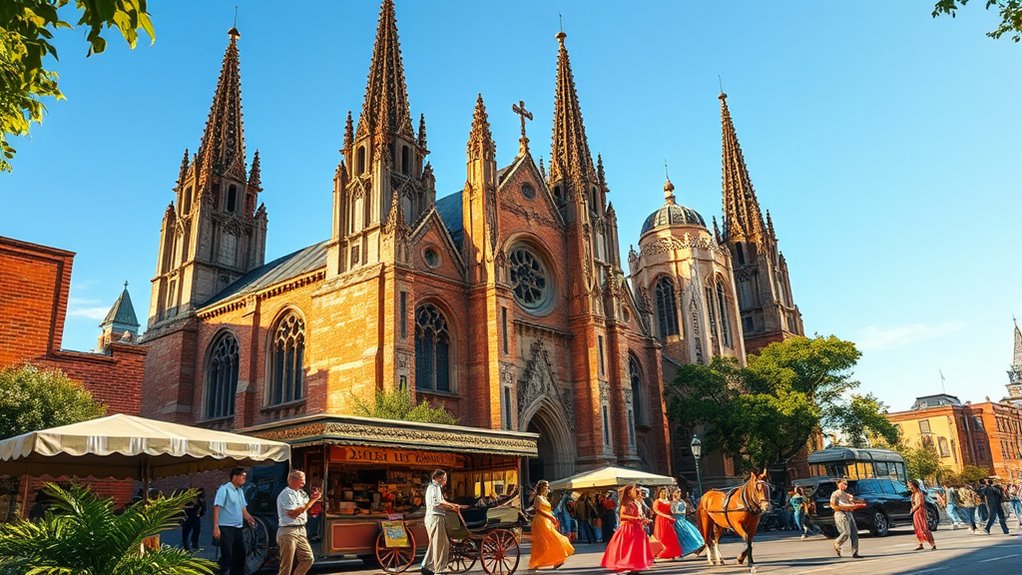The South’s history begins with European colonies, a plantation economy fueled by slavery, and a rich African American heritage. It’s known for its music, cuisine, and regional pride rooted in traditions like blues, jazz, barbecue, and festivals. The region struggled with racial tensions, slavery, and segregation but also made significant social changes through civil rights movements. If you explore further, you’ll discover how these historic roots still influence the South’s vibrant culture today.
Key Takeaways
- The South’s history includes European colonization, slavery, Civil War, Reconstruction, and ongoing struggles for civil rights.
- Its culture features distinctive music genres like blues, jazz, country, and soul food traditions.
- The region’s economy shifted from plantation agriculture to manufacturing, technology, and service industries.
- Segregation laws and social movements shaped racial dynamics and civil rights efforts in Southern society.
- Regional identity is expressed through festivals, dialects, culinary traditions, and pride in historical heritage.
Early Colonial Foundations and Revolutionary Beginnings

Have you ever wondered how the early foundations of the South shaped its future? It all started with European explorers establishing colonies—Spanish in Florida, French along the Mississippi, and English in Virginia and the Carolinas. These settlements laid the groundwork for a plantation economy centered on cash crops like tobacco, rice, indigo, and later cotton. Enslaved Africans provided the labor that fueled this system, embedding slavery deeply into Southern society. During the colonial and Revolutionary periods, colonies like Virginia and the Carolinas played active roles in the fight for independence, while others like South Carolina had significant Loyalist populations. Early governance and economic practices established a pattern that would influence the South’s social and political landscape for generations.
The Rise and Impact of the Cotton Economy and Slavery

You see, the cotton economy’s rapid growth transformed the South into a powerhouse of agricultural wealth. This expansion depended heavily on enslaved labor, shaping society’s structure and economy. As a result, slavery’s influence created lasting social and cultural consequences that still echo today. The impact on societal structures was profound, influencing everything from social hierarchies to cultural identities in the region.
Cotton’s Economic Expansion
The rise of the cotton economy in the South transformed its social and economic landscape, fueling rapid growth and deepening reliance on enslaved labor. Cotton became the dominant crop, boosting plantation profits and expanding slavery’s reach. This economic shift led to increased demand for land, more enslaved people, and powerful planter aristocrats. As cotton fields spread, towns and transportation networks grew to support exports. The table below illustrates key aspects:
| Aspect | Impact |
|---|---|
| Cotton Production | Dominated Southern agriculture |
| Slave Labor | Expanded with cotton’s growth |
| Plantation Wealth | Increased, creating social elite |
| Transportation | Railroads and ports expanded |
| Market Integration | Connected South to global markets |
This expansion solidified cotton’s role as the South’s economic backbone. Additionally, the growth of the cotton economy facilitated the development of market economies that integrated Southern producers into the broader global trade network.
Enslaved Labor Foundation
The explosive growth of the cotton economy in the South was built on the forced labor of enslaved Africans and their descendants. You can see how this labor fueled the expansion of plantations, making cotton the backbone of southern wealth. Enslaved people worked long hours under brutal conditions, often with little hope of freedom. Their forced labor created immense profits for plantation owners and helped establish a deeply rooted system of racial inequality. This foundation allowed the South’s economy to flourish but also entrenched slavery as an essential institution. As cotton exports skyrocketed, so did the demand for enslaved labor, shaping the social and political landscape of the region. This system’s legacy still influences the South’s demographics, culture, and ongoing struggles with racial justice today. The brutal conditions and the systemic exploitation underscored the cybersecurity vulnerabilities that left enslaved people vulnerable to further oppression and control.
Societal Consequences of Slavery
The rise of the cotton economy transformed Southern society, embedding slavery deeply into its economic, social, and political fabric. This shift created a racial hierarchy that justified exploitation and fueled tensions. Slavery’s legacy shaped laws, culture, and identity, reinforcing segregation and inequality. Its impact is evident in social divisions that persist today. The following table highlights key consequences:
| Consequences | Effects | Long-term Impact |
|---|---|---|
| Economic dependence | Reliance on slave labor | Persistent poverty in some areas |
| Racial hierarchy | Justification of segregation | Ongoing racial tensions |
| Political power | Slaves as property, influence | Disenfranchisement of African Americans |
| Cultural identity | Slavery shaping traditions | Debates over Confederate symbols |
| Social divisions | Class and race disparities | Continued struggle for equality |
A significant legacy of slavery is the deep-rooted social and economic disparities that continue to influence contemporary society.
The Civil War, Emancipation, and Reconstruction

Have you ever wondered how the Civil War transformed the South and its people? The war tore through the region, leaving destruction everywhere. When it ended, slavery was abolished through the Emancipation Proclamation and the 13th Amendment, freeing millions of enslaved African Americans. But freedom didn’t mean equality; during Reconstruction, the federal government tried to rebuild the South and grant civil rights to freedmen. Instead, white supremacist groups like the Ku Klux Klan emerged, enforcing segregation and disenfranchisement through Black Codes and Jim Crow laws. Reconstruction officially ended in 1877, allowing white Democrats to regain control and implement policies that suppressed African Americans’ rights. This period fundamentally reshaped Southern society, laying the groundwork for ongoing racial tensions and struggles for justice. The rise of segregation laws during this time further entrenched racial inequalities in the region.
Segregation, Jim Crow Laws, and Civil Rights Movements

You see, after Reconstruction, Jim Crow laws enforced racial segregation and limited African Americans’ rights for decades. Civil rights activists fought tirelessly against these laws, challenging injustice through protests, legal battles, and sit-ins. The impact of segregation shaped Southern society, fueling ongoing struggles for equality and justice. Additionally, the cultural significance of pinball machines grew during this period, serving as popular entertainment in segregated communities and arcades.
Jim Crow Legislation
After the Civil War, Southern states enacted a series of laws collectively known as Jim Crow laws to enforce racial segregation and maintain white supremacy. These laws segregated schools, public transportation, restaurants, and even restrooms, creating a system of racial separation that disadvantaged African Americans. They also restricted voting rights through poll taxes, literacy tests, and intimidation, effectively disenfranchising Black citizens. You’d find that Jim Crow policies reinforced social hierarchies, making segregation seem normal and acceptable. White supremacy was embedded in everyday life, and challenging these laws often meant risking violence or social ostracism. Despite these injustices, African Americans resisted through activism, legal challenges, and community efforts, laying the groundwork for the Civil Rights Movement that would challenge Jim Crow’s grip on American society. Recognizing the subconscious power utilized to uphold these laws highlights the importance of awareness and collective action in transforming societal beliefs.
Civil Rights Activism
The enforcement of Jim Crow laws solidified racial segregation across the South, prompting African Americans to resist through acts of civil disobedience and organized activism. You witness the courage of individuals like Rosa Parks, whose refusal to give up her bus seat sparked the Montgomery Bus Boycott. You see leaders like Dr. Martin Luther King Jr. organizing marches, sit-ins, and speeches to challenge injustice. You learn how grassroots efforts, legal battles, and nonviolent protests gradually dismantled segregation’s grip. The Civil Rights Movement gains momentum, inspiring millions to demand equality and justice. Despite violent opposition, you recognize that these acts of activism laid the foundation for significant legal and social change, shaping a more equitable future for all. Additionally, the movement’s success was supported by the strategic use of technology private placement investments to fund and promote civil rights initiatives.
Racial Segregation Impact
Racial segregation deeply shaped the South’s social landscape through the implementation of Jim Crow laws, which mandated separate facilities and services for Black and white citizens. These laws created systemic inequality, limiting access to quality education, healthcare, and public spaces for Black Americans. You should recognize how:
- Segregation reinforced racial stereotypes and social hierarchies.
- Black neighborhoods and schools received inferior resources and funding.
- Disenfranchisement prevented many from voting or participating politically.
- Civil rights protests challenged these injustices, leading to landmark legislation.
- The legacy of preppy dog names and other cultural influences can be seen in various social movements and traditions.
This era fostered deep racial divides, making equality a long struggle. The fight against segregation fueled activism, culminating in significant advances during the Civil Rights Movement, and continues to influence social debates today.
Cultural Heritage: Music, Cuisine, and Regional Identity

Southern culture is vividly expressed through its distinctive music, flavorful cuisine, and strong regional identity. You’ll notice the soulful sounds of blues, jazz, country, and rock ’n’ roll that have shaped America’s musical landscape. The cuisine is just as rich, featuring dishes like barbecue, fried chicken, grits, and soul food that reflect the South’s agricultural roots and diverse influences. These culinary traditions often bring communities together at family gatherings and festivals. Your regional identity is also visible in the pride Southerners feel for their history and customs, from traditional festivals to local dialects. This vibrant cultural heritage preserves the legacy of the South’s complex history while fostering a sense of belonging and pride among its people. Additionally, the region’s diverse musical styles continue to influence contemporary artists and keep Southern traditions alive.

As the South continues to evolve, its economy has shifted away from traditional agriculture toward manufacturing, technology, and service industries, transforming urban centers into vibrant hubs of innovation. You see cities like Atlanta, Houston, and Miami leading this change, attracting businesses and talent. However, ongoing social debates still shape the region’s identity:
The South’s economy shifts from agriculture to innovation, fueling urban growth amid ongoing social debates.
- Racial tensions persist, fueled by historical inequalities and modern disparities.
- Poverty remains a challenge, especially in rural areas and marginalized communities.
- Education gaps highlight ongoing struggles for equality and opportunity.
- Confederate symbols and historical memory spark heated discussions about heritage versus unity.
Despite these issues, cultural vibrancy continues to thrive through music, cuisine, and community activism. The South’s transformation reflects both its resilient history and its push toward progress.
Frequently Asked Questions
How Did the Great Migration Influence Southern Demographics?
The Great Migration profoundly changed southern demographics by moving over six million African Americans from the rural South to northern and western cities. You’ll notice the increased urban populations and diverse communities in places like Chicago, Detroit, and Los Angeles. This migration reduced the African American population in the South, shifted cultural influences, and contributed to the growth of vibrant Black cultural movements, shaping the region’s social and political landscape today.
What Role Did Native American Tribes Play in Southern History?
Native American tribes shaped southern history like intricate threads weaving through a tapestry. You see, they inhabited the land long before European settlers arrived, influencing culture, trade, and territorial boundaries. Tribes such as the Cherokee, Seminole, and Chickasaw resisted colonization, fought wars, and faced forced removals like the Trail of Tears. Their legacy endures in place names, traditions, and ongoing struggles for rights, reminding you that their story is an essential part of the South’s fabric.
How Did the South’s Economy Transition After the Decline of Agriculture?
You see the South’s economy shift from agriculture to manufacturing and services after agriculture declined. As farms became less dominant, cities grew, attracting industries like textiles, automobiles, and tech. You notice the rise of Sun Belt cities like Atlanta and Houston, which became economic hubs. This shift also brought diversification, more jobs, and urbanization, transforming the Southern economy from a plantation-based system to a modern, dynamic regional economy.
What Are the Lasting Effects of Jim Crow Laws Today?
You see that Jim Crow laws have left deep-rooted racial inequalities today. They created systemic segregation, disenfranchisement, and economic disparities that persist in education, housing, and employment opportunities for African Americans. Even after their abolition, these laws fostered attitudes of racial bias and discrimination. As a result, you might notice ongoing struggles with racial justice, disparities in wealth, and debates over symbols and monuments linked to this painful history.
How Does Regional Identity Shape Southern Political Perspectives?
You see regional identity shaping southern political perspectives through a strong sense of tradition, pride, and resistance to change. You might notice how values like individualism, states’ rights, and cultural heritage influence attitudes toward government, civil rights, and social issues. This identity fosters loyalty to local institutions and a cautious approach to federal policies, often leading to conservative viewpoints that emphasize preserving regional history and resisting external influences.
Conclusion
Your journey through the South’s history reveals a tapestry so rich and intense, it’s like the heartbeat of America itself. From revolutionary fires to civil rights revolutions, every chapter is a rollercoaster of passion, struggle, and triumph. The South’s culture isn’t just alive — it’s a blazing inferno of music, food, and identity that refuses to be extinguished. This region’s story is the soul of the nation, and it’ll keep burning brighter than ever.









